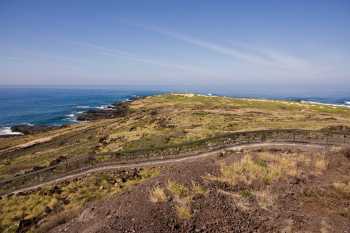The Hawaii Department of Land and Natural Resources (DLNR) has completed construction of the first predator-proof fence in the Hawaiian Islands, and in the United States, at the Ka‘ena Point Natural Area Reserve on Oahu. Spanning 700 m in length and running across a coastal peninsula, it provides a safe habitat for numerous seabirds, including several hundred Laysan Albatrosses Phoebastria immutabilis and thousands of Wedge-tailed Shearwaters Puffinus pacificus, as well as 11 endangered plant species.
Unlocked double-door gates have been installed at major entry-ways to allow continued use of the reserve seven days a week for hiking, bird-watching, fishing, cultural practices and volunteer work.

The predator-proof fence will keep predators such as cats, dogs, mongooses, rats and mice out of the reserve so that native species, including the breeding population of Laysan Albatrosses, can flourish. Because the recent tsunami caused the loss of more than a hundred thousand albatrosses on the Northwestern Hawaiian Islands (click here), the necessity for elevated breeding areas such as Ka‘ena Point is apparent, especially in the light of expected sea level rise due to climate change.
The protected area is now close to being free of predators as a result of intensive baiting and trapping efforts. Before construction the reserve had feral dogs, cats, mongooses, rats and mice within it and predation rates approached 15% of fledgling birds each year despite intensive predator control. Scientific monitoring of all aspects of the habitat, from seabird reproductive success to plant recruitment to soil nutrients, is being undertaken to track the results of the fence over time. Methods are in place to detect if pests have re-entered the reserve so that a rapid response can be implemented in the event of a pest breach.
Although an overwhelming majority of people who have visited Ka‘ena Point has been in strong support of the project, modifications to the design have been made to address concerns expressed, including the installation of a third walk-through gate.
With the completion of the fence it is hoped that the populations of breeding seabirds will increase and that small petrel species currently unable to utilize the reserve as a result of predation pressure will begin nesting within it.

The project has been made possible by a partnership among the State Department of Land and Natural Resources, the U.S. Fish and Wildlife Service, and the Hawai‘i Chapter of the Wildlife Society. Funding was provided by the USFWS through its coastal programme for the fence construction and public outreach. The David and Lucile Packard Foundation funded the biological monitoring and pest removal. For more information visit the Ka'ena Point Ecosystem Restoration Project.
Search on Kaena Point on this web site to read earlier stories on the reserve and its predator-proof fence.
Lindsay Young, ACAP North American News Correspondent, 2 April 2011

 English
English  Français
Français  Español
Español